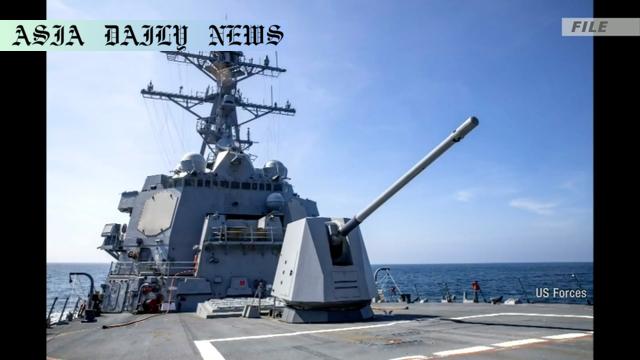Taiwan Strait: U.S. Navy conducts historic transit since Trump’s inauguration, sparking heightened China tensions.
U.S. Navy vessels transited Taiwan Strait for the first time since Trump’s inauguration.
China condemned the U.S. action, labeling it a risk to stability.
Operation highlights freedom of navigation in international waters.

Introduction: The Historic Naval Transit
The United States Navy has carried out a significant mission by transiting two of its vessels through the Taiwan Strait. The mission marks the first such operation since former President Donald Trump’s inauguration and reflects Washington’s staunch commitment to international navigation freedoms. This decision has, however, escalated tensions with the Chinese government, which considers Taiwan as a core sovereign issue. Observers point out that the operation comes during highly sensitive times, indicating strategic messaging from the U.S. amid Washington-Beijing rivalry.
Key Details of the Operation
On this routine mission, the Arleigh Burke-class guided-missile destroyer USS Ralph Johnson and the Pathfinder-class survey ship USNS Bowditch sailed through the Taiwan Strait between Monday and Wednesday. The U.S. Indo-Pacific Command, responsible for overseeing such operations, clarified that the passage was in keeping with standard practice, further reaffirming that freedom of navigation within international waters remains essential under maritime laws.
The Chinese Reaction
Unsurprisingly, China condemned the operation, with the Eastern Theater Command issuing a strong rebuke. Chinese officials denounced the transit as provocative, accusing the U.S. of sending “wrong signals” that could destabilize peace and escalate security risks. Furthermore, the state-run China Central Television reported that the command was engaged in readiness exercises near Taiwan, showcasing Beijing’s military preparedness and swift ability to transition to combat control if required.
Geopolitical Implications
This recent development highlights the fragile and often contentious state of U.S.-China relations. By conducting this transit, the United States emphasized its unwillingness to cede control over critical international waterways, underscoring the region’s strategic importance. For Beijing, this maneuver was a further affront to its longstanding claims over Taiwan and the surrounding waters, sparking concerns of intensifying regional hostility.
Freedom of Navigation as a Principle
The U.S. Navy enforces freedom of navigation as a core tenet of its military and geopolitical strategy. The Taiwan Strait has been a focal point for such operations, as its control influences global shipping routes, regional economic balances, and international alliances. Past U.S. administrations have upheld this principle despite diplomatic protests and growing regional militarization. However, such actions also bring with them inherent risks of escalation.
Historical Context
U.S. naval operations in the Taiwan Strait have been a recurring flashpoint in international relations. Since the 1970s, operations in the region have shifted depending on the prevailing political administration and global dynamics. During Trump’s administration, U.S.-China relations saw increased turbulence, owing to a combination of trade wars, military posturing, and ideological divides over Taiwan’s sovereignty. In some cases, these operations are explicitly conducted to counterbalance China’s growing influence in the region.
China’s Military Maneuvers
Alongside diplomatic protest, China’s Eastern Theater Command has been actively enhancing its military readiness. Recent reports indicate increasing patrols and exercises near Taiwan, many of which coincide with U.S. naval activity. By maintaining a high-alert status, Beijing is signaling its capability and readiness to counter any perceived foreign interference in the area. This constitutes a broader strategy of power projection aimed at deterring external forces from challenging its claims while bolstering domestic narratives of control and strength.
Closing Thoughts
The U.S. Navy’s decision to transit the Taiwan Strait holds significant implications for international security, diplomacy, and freedom of navigation. This strategic maneuver underscores Washington’s resolve amid intensifying geopolitical rivalry with Beijing. However, it also serves as a stark reminder of the fragility of regional peace, as two of the world’s leading powers contend for influence in one of the most politically sensitive regions globally. Moving forward, such actions will undoubtedly continue to shape the evolving contours of 21st-century geopolitics.
Commentary
Significance of the Naval Transit
The recent U.S. Navy transit through the Taiwan Strait is a bold and calculated move meant to reaffirm America’s dedication to a free and open Indo-Pacific. At its core, this mission is not just a routine operation but a strategic message affirming international maritime laws. Such activities are critical in preserving global order, especially when certain nations attempt to claim sovereignty beyond universally recognized boundaries.
China’s Shift in Strategy
China’s response to the transit highlights an increasing assertiveness in its foreign policy approach. The Eastern Theater Command’s military exercises around Taiwan are a clear indication of Beijing’s determination to portray dominance. It reflects the broader power struggle between the U.S. and China, one that encompasses trade conflicts, technology rivalries, and military posturing across regions.
Balancing Diplomacy and Strategy
While the United States emphasizes freedom of navigation, it must also tread carefully to avoid escalating tensions into outright conflict. This requires thoughtful, multi-pronged diplomacy alongside military readiness. Dialogue with China remains a necessity to ensure that these operations do not inadvertently open the door to broader hostilities, especially over Taiwan, a region prone to high sensitivities for both parties.
Final Reflections
The Taiwan Strait incident serves as a defining moment for U.S.-China relations and their respective roles on the world stage. While such shows of strength underline respective national priorities, they are also stark reminders of the delicate balance between competition and cooperation in maintaining global peace. Both nations bear the responsibility of navigating these turbulent waters with caution and foresight in the years ahead.


